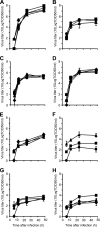In vitro assessment of attachment pattern and replication efficiency of H5N1 influenza A viruses with altered receptor specificity
- PMID: 20392847
- PMCID: PMC2903244
- DOI: 10.1128/JVI.02737-09
In vitro assessment of attachment pattern and replication efficiency of H5N1 influenza A viruses with altered receptor specificity
Abstract
The continuous circulation of the highly pathogenic avian influenza (HPAI) H5N1 virus has been a cause of great concern. The possibility of this virus acquiring specificity for the human influenza A virus receptor, alpha2,6-linked sialic acids (SA), and being able to transmit efficiently among humans is a constant threat to human health. Different studies have described amino acid substitutions in hemagglutinin (HA) of clinical HPAI H5N1 isolates or that were introduced experimentally that resulted in an increased, but not exclusive, binding of these virus strains to alpha2,6-linked SA. We introduced all previously described amino acid substitutions and combinations thereof into a single genetic background, influenza virus A/Indonesia/5/05 HA, and tested the receptor specificity of these 27 mutant viruses. The attachment pattern to ferret and human tissues of the upper and lower respiratory tract of viruses with alpha2,6-linked SA receptor preference was then determined and compared to the attachment pattern of a human influenza A virus (H3N2). At least three mutant viruses showed an attachment pattern to the human respiratory tract similar to that of the human H3N2 virus. Next, the replication efficiencies of these mutant viruses and the effects of three different neuraminidases on virus replication were determined. These data show that influenza virus A/Indonesia/5/05 potentially requires only a single amino acid substitution to acquire human receptor specificity, while at the same time remaining replication competent, thus suggesting that the pandemic threat posed by HPAI H5N1 is far from diminished.
Figures



References
-
- Auewarakul, P., O. Suptawiwat, A. Kongchanagul, C. Sangma, Y. Suzuki, K. Ungchusak, S. Louisirirotchanakul, H. Lerdsamran, P. Pooruk, A. Thitithanyanont, C. Pittayawonganon, C. T. Guo, H. Hiramatsu, W. Jampangern, S. Chunsutthiwat, and P. Puthavathana. 2007. An avian influenza H5N1 virus that binds to a human-type receptor. J. Virol. 81:9950-9955. - PMC - PubMed
-
- Banks, J., E. S. Speidel, E. Moore, L. Plowright, A. Piccirillo, I. Capua, P. Cordioli, A. Fioretti, and D. J. Alexander. 2001. Changes in the hemagglutinin and the neuraminidase genes prior to the emergence of highly pathogenic H7N1 avian influenza viruses in Italy. Arch. Virol. 146:963-973. - PubMed
-
- Baum, L. G., and J. C. Paulson. 1991. The N2 neuraminidase of human influenza virus has acquired a substrate specificity complementary to the hemagglutinin receptor specificity. Virology 180:10-15. - PubMed
-
- Chandrasekaran, A., A. Srinivasan, R. Raman, K. Viswanathan, S. Raguram, T. M. Tumpey, V. Sasisekharan, and R. Sasisekharan. 2008. Glycan topology determines human adaptation of avian H5N1 virus hemagglutinin. Nat. Biotechnol. 26:107-113. - PubMed
Publication types
MeSH terms
Substances
Grants and funding
LinkOut - more resources
Full Text Sources
Medical

